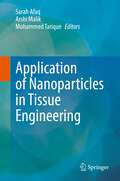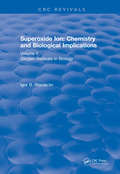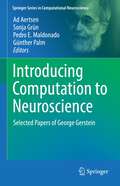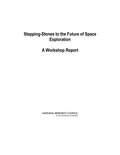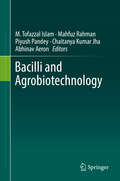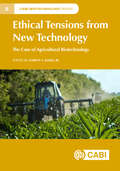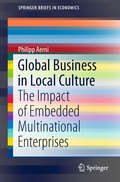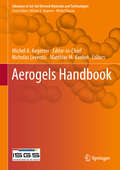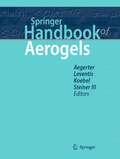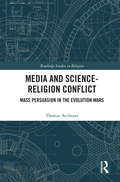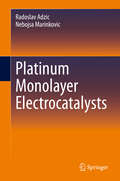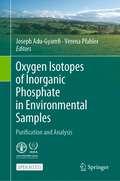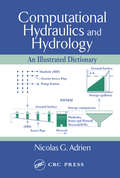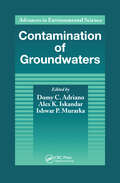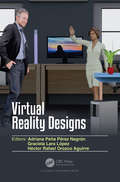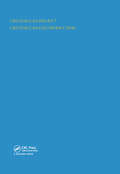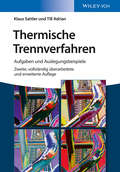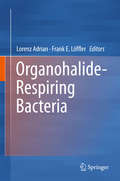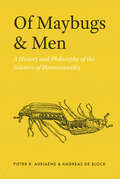- Table View
- List View
Florida Holt Science & Technology, Level Green
by Mario Affatigato Katy Z. Allen Linda Ruth BergNIMAC-sourced textbook
Application of Nanoparticles in Tissue Engineering
by Sarah Afaq Arshi Malik Mohammed TariqueThis book discusses advancements in the applications of nanoparticles in tissue engineering. It examines the applications of nanobiomaterials in hard tissue regeneration, fabrication, and characterization. The book also analyzes the implication of three-dimensional and four-dimensional fabrication techniques for the production of the scaffold in tissue engineering and their advantages over conventional scaffold production techniques. Further, it presents smart materials used in making 4-D scaffolds that imitate the dynamic response of tissue against natural stimuli and adapt to the microenvironment by changing their conformation or other properties. It also summarizes the growing field of biomolecular detection and biosensors in tissue engineering and the increasing prominence of nanoparticles in the biosensors. Further, it provides the future outlook and associated challenges of the application of nanomaterials in tissue engineering.
Superoxide Ion: Chemistry and Biological Implications (CRC Press Revivals)
by Igor B. Afanas'evThe chemical properties of superoxide ion, its biological role, and the role of other oxygen radicals which arise as a result of its transformations are contained in this text. In Volume I the principal reactions of superoxide ion, including protonation reactions with proton donors, nucleophilic reactions with esters, alkyl halides and other compounds, electron transfer reactions with quinones and metal complexes, are described.
Introducing Computation to Neuroscience: Selected Papers of George Gerstein (Springer Series in Computational Neuroscience)
by Ad Aertsen Sonja Grün Pedro E. Maldonado Günther PalmThis book brings together a selection of papers by George Gerstein, representing his long-term endeavor of making neuroscience into a more rigorous science inspired by physics, where he had his roots. Professor Gerstein was many years ahead of the field, consistently striving for quantitative analyses, mechanistic models, and conceptual clarity. In doing so, he pioneered Computational Neuroscience, many years before the term itself was born. The overarching goal of George Gerstein’s research was to understand the functional organization of neuronal networks in the brain. The editors of this book have compiled a selection of George Gerstein’s many seminal contributions to neuroscience--be they experimental, theoretical or computational--into a single, comprehensive volume .The aim is to provide readers with a fresh introduction of these various concepts in the original literature. The volume is organized in a series of chapters by subject, ordered in time, each one containing one or more of George Gerstein’s papers.
Limiting Future Collision Risk to Spacecraft: An Assessment of NASA's Meteoroid and Orbital Debris Programs
by Aeronautics Space Engineering BoardDerelict satellites, equipment and other debris orbiting Earth (aka space junk) have been accumulating for many decades and could damage or even possibly destroy satellites and human spacecraft if they collide. During the past 50 years, various National Aeronautics and Space Administration (NASA) communities have contributed significantly to maturing meteoroid and orbital debris (MMOD) programs to their current state. Satellites have been redesigned to protect critical components from MMOD damage by moving critical components from exterior surfaces to deep inside a satellite's structure. Orbits are monitored and altered to minimize the risk of collision with tracked orbital debris. MMOD shielding added to the International Space Station (ISS) protects critical components and astronauts from potentially catastrophic damage that might result from smaller, untracked debris and meteoroid impacts. Limiting Future Collision Risk to Spacecraft: An Assessment of NASA's Meteoroid and Orbital Debris Program examines NASA's efforts to understand the meteoroid and orbital debris environment, identifies what NASA is and is not doing to mitigate the risks posed by this threat, and makes recommendations as to how they can improve their programs. While the report identified many positive aspects of NASA's MMOD programs and efforts including responsible use of resources, it recommends that the agency develop a formal strategic plan that provides the basis for prioritizing the allocation of funds and effort over various MMOD program needs. Other necessary steps include improvements in long-term modeling, better measurements, more regular updates of the debris environmental models, and other actions to better characterize the long-term evolution of the debris environment.
Limiting Future Collision Risk to Spacecraft: An Assessment of NASA's Meteoroid and Orbital Debris Programs
by Aeronautics Space Engineering BoardDerelict satellites, equipment and other debris orbiting Earth (aka space junk) have been accumulating for many decades and could damage or even possibly destroy satellites and human spacecraft if they collide. During the past 50 years, various National Aeronautics and Space Administration (NASA) communities have contributed significantly to maturing meteoroid and orbital debris (MMOD) programs to their current state. Satellites have been redesigned to protect critical components from MMOD damage by moving critical components from exterior surfaces to deep inside a satellite's structure. Orbits are monitored and altered to minimize the risk of collision with tracked orbital debris. MMOD shielding added to the International Space Station (ISS) protects critical components and astronauts from potentially catastrophic damage that might result from smaller, untracked debris and meteoroid impacts. Limiting Future Collision Risk to Spacecraft: An Assessment of NASA's Meteoroid and Orbital Debris Program examines NASA's efforts to understand the meteoroid and orbital debris environment, identifies what NASA is and is not doing to mitigate the risks posed by this threat, and makes recommendations as to how they can improve their programs. While the report identified many positive aspects of NASA's MMOD programs and efforts including responsible use of resources, it recommends that the agency develop a formal strategic plan that provides the basis for prioritizing the allocation of funds and effort over various MMOD program needs. Other necessary steps include improvements in long-term modeling, better measurements, more regular updates of the debris environmental models, and other actions to better characterize the long-term evolution of the debris environment.
Stepping-Stones to the Future of Space Exploration: A Workshop Report
by Aeronautics Space Engineering BoardNASA’s Human Exploration and Development of Space (HEDS) program within the Office of Space Flight has proposed a new framework for space technology and systems development—Advanced Systems, Technology, Research, and Analysis (ASTRA) for future space flight capabilities. To assist in the development of this framework, NASA asked the National Research Council to convene a series of workshops on technology policy issues concerning the relationship of the various stakeholders in advancing human and robotic exploration and development of space. The first workshop, which is the topic of this report, focused on policy issues about the development and demonstration of space technologies. Four policy topics—selected by the project steering committee as the foci of this first workshop—are discussed in the report: the rationale for human and robotic space exploration; technology as a driver for capability transformation; risk mitigation and perception; and international cooperation and competition.
Bacilli and Agrobiotechnology (Bacilli in Climate Resilient Agriculture and Bioprospecting)
by Abhinav Aeron M. Tofazzal Islam Mahfuz Rahman Piyush Pandey Chaitanya Kumar JhaThis volume of comprehensive reviews updates our knowledge of research and commercialization of Bacillus-based products in agriculture and the environmental sector. The last couple of decades have witnessed tremendous growth of research on Bacillus species. Many of these species can produce industrial enzymes, and can act simultaneously as biofertilizers and as biopesticides inhibiting important phytopathogens. This "biocontrol" activity is now elucidated by a number of genomic and metabolomic studies. Bacillus formulations are being patented and commercialized on a regular basis. Understanding the biology, ecology and mechanism of action of these bacteria will play a role in the promotion of Bacillus-based products to support green technology in agriculture and agro-based industries.
Ethical Tensions from New Technology: The Case of Agricultural Biotechnology
by Philipp Aerni Rachel A. Ankeny Bartosz Bartkowski Heather J. Bray Bradley Martin Jones Deepthi E. Kolady Jane Kolodinsky Katie M. MacDonald Kelly A. McKinley Desmond Ng Frauke Pirscher Roberto Quiroz Dane Scott Shivendra Kumar Srivastava Debra M. Strauss Insa Theesfeld Johannes Timaeus Corrine Valdivia Duane WindsorThe introduction of new technologies can be controversial, especially when they create ethical tensions as well as winners and losers among stakeholders and interest groups. While ethical tensions resulting from the genetic modification of crops and plants and their supportive gene technologies have been apparent for decades, persistent challenges remain. This book explores the contemporary nature, type, extent and implications of ethical tensions resulting from agricultural biotechnology specifically and technology generally. There are four main arenas of ethical tensions: public opinion, policy and regulation, technology as solutions to problems, and older versus new technologies. Contributions focus on one or more of these arenas by identifying the ethical tensions technology creates and articulating emerging fault lines and, where possible, viable solutions. Key features include: Focusing on contemporary challenges created by new and emerging technologies, especially agricultural biotechnology. Identifying a unique perspective by considering the problem of ethical tensions created or enhanced by new technologies. Providing an interdisciplinary perspective by including perspectives from sociologists, economists, philosophers and other social scientists. This book will be of interest to academics in agricultural economics, sociology and philosophy and policymakers concerned with introducing new technology into agriculture.
Global Business in Local Culture: The Impact Of Embedded Multinational Enterprises (SpringerBriefs in Economics)
by Philipp AerniThis book examines the impact of multinational enterprises (MNEs) on local economies, and presents selected case studies of MNEs operating in low income countries. By balancing external social and environmental costs against its corresponding benefits, the book demonstrates that MNEs can have a positive net-impact on local development if they build up social capital by embedding themselves in local economies and engaging responsibly with local stakeholders. By doing so MNEs contribute to inclusive growth, a cental pillar of the UN Sustainable Development Goals. In this context, the book challenges popular narratives in civil society and academia that frame foreign direct investment (FDI) merely as a threat to human rights and sustainable development. Moreover, it offers practical guidance for globally operating businesses seeking to establish progressive Corporate Social Responsibility (CSR) strategies of their own.
Aerogels Handbook (Advances in Sol-Gel Derived Materials and Technologies)
by Michel Andre Aegerter Matthias M. Koebel Nicholas LeventisAerogels are the lightest solids known. Up to 1000 times lighter than glass and with a density as low as only four times that of air, they show very high thermal, electrical and acoustic insulation values and hold many entries in Guinness World Records. Originally based on silica, R&D efforts have extended this class of materials to non-silicate inorganic oxides, natural and synthetic organic polymers, carbon, metal and ceramic materials, etc. Composite systems involving polymer-crosslinked aerogels and interpenetrating hybrid networks have been developed and exhibit remarkable mechanical strength and flexibility. Even more exotic aerogels based on clays, chalcogenides, phosphides, quantum dots, and biopolymers such as chitosan are opening new applications for the construction, transportation, energy, defense and healthcare industries. Applications in electronics, chemistry, mechanics, engineering, energy production and storage, sensors, medicine, nanotechnology, military and aerospace, oil and gas recovery, thermal insulation and household uses are being developed with an estimated annual market growth rate of around 70% until 2015. The Aerogels Handbook summarizes state-of-the-art developments and processing of inorganic, organic, and composite aerogels, including the most important methods of synthesis, characterization as well as their typical applications and their possible market impact. Readers will find an exhaustive overview of all aerogel materials known today, their fabrication, upscaling aspects, physical and chemical properties, and most recent advances towards applications and commercial products, some of which are commercially available today. Key Features: *Edited and written by recognized worldwide leaders in the field *Appeals to a broad audience of materials scientists, chemists, and engineers in academic research and industrial R&D *Covers inorganic, organic, and composite aerogels *Describes military, aerospace, building industry, household, environmental, energy, and biomedical applications among others
Springer Handbook of Aerogels (Springer Handbooks)
by Michel A. Aegerter Nicholas Leventis Matthias Koebel Stephen A. SteinerThis indispensable handbook provides comprehensive coverage of the current state-of-the-art in inorganic, organic, and composite aerogels – from synthesis and characterization to cutting-edge applications and their potential market impact. Built upon Springer’s successful Aerogels Handbook published in 2011, this handbook features extensive revisions and timely updates, reflecting the changes in this fast-growing field. Aerogels are the lightest solids known to man. Up to 1000 times lighter than glass and with a density only four times that of air, they possess extraordinarily high thermal, electrical, and acoustic insulation properties, and boast numerous entries in Guinness World Records. Originally based on silica, R&D efforts have extended this class of materials to incorporate non-silicate inorganic oxides, natural and synthetic organic polymers, carbon, metal, and ceramic materials. Composite systems involving polymer-crosslinked aerogels and interpenetrating hybrid networks have been developed and exhibit remarkable mechanical strength and flexibility. Even more exotic aerogels based on clays, chalcogenides, phosphides, quantum dots, and biopolymers such as chitosan are opening new applications for the construction, transportation, energy, defense and healthcare industries. Applications in electronics, chemistry, mechanics, engineering, energy production and storage, sensors, medicine, nanotechnology, military and aerospace, oil and gas recovery, thermal insulation, and household uses are being developed.Readers of this fully updated and expanded edition will find an exhaustive source for all aerogel materials known today, their fabrication, upscaling aspects, physical and chemical properties, and the most recent advances towards applications and commercial use. This key reference is essential reading for a combined audience of graduate students, academic researchers, and industry professionals.
Introductory Physics for Biological Scientists
by Christof M. AegerterWhy do elephants have sturdier thigh bones than humans? Why can't ostriches fly? How do bacteria swim through fluids? With each chapter structured around relevant biological case studies and examples, this engaging, full-colour book introduces fundamental physical concepts essential in the study of biological phenomena. Optics is introduced within the context of butterfly wing colouration, electricity is explained through the propagation of nerve signals, and accelerated motion is conveniently illustrated using the example of the jumping armadillo. Other key physical concepts covered include waves, mechanical forces, thermodynamics and magnetism, and important biological techniques are also discussed within this context, such as gel electrophoresis and fluorescence microscopy. A detailed appendix provides further discussion of the mathematical concepts utilised within the book, and numerous exercises and quizzes allow readers to test their understanding of key concepts. This book is invaluable to students aiming to improve their quantitative and analytical skills and understand the deeper nature of biological phenomena.
Media and Science-Religion Conflict: Mass Persuasion in the Evolution Wars (Routledge Studies in Religion)
by Thomas AechtnerThis book examines why the religion-science skirmishes known as the Evolution Wars have persisted into the 21st century. It does so by considering the influences of mass media in relation to decision-making research and the Elaboration Likelihood Model, one of the most authoritative persuasion theories. The book’s analysis concentrates on the expression of cues, or cognitive mental shortcuts, in Darwin-sceptic and counter-creationist broadcasts. A multiyear collection of media generated by the most prominent Darwin-sceptic organizations is surveyed, along with rival publications from supporters of evolutionary theory described as the pro-evolutionists. The analysed materials include works produced by Young Earth Creationist and Intelligent Design media makers, New Atheist pacesetters, as well as both agnostic and religious supporters of evolution. These cues are shown to function as subtle but effective means of shaping public opinion, including appeals to expertise, claims that ideas are being censored, and the tactical use of statistics and technical jargon. Contending that persuasive mass media is a decisive component of science-religion controversies, this book will be of keen interest to scholars of Religion, Science and Religion interactions, as well as researchers of Media and Communication Studies more generally.
Platinum Monolayer Electrocatalysts
by Radoslav Adzic Nebojsa MarinkovicThis book describes a science and technology of a new type of electrocatalysts consisting of a single atomic layer of platinum on suitable supports. This development helped overcome three major obstacles—catalysts‘ cost, activity, and stability—for a broad range of fuel cell applications. The volume begins with a short introduction to the science of electrocatalysis, covering four reactions important for energy conversion in fuel cells. A description follows of the properties of metal monolayers on electrode surfaces, and underpotential deposition of metals. The authors then describe the concept of Pt monolayer electrocatalysts and its implications and their synthesis by galvanic displacement of less-noble metal monolayers and other methods. The main part of the book presents a discussion of catalysts’ characterization and catalytic properties of Pt monolayers for the four main reactions of electrochemical energy conversion: oxygen reduction and oxidation of hydrogen, methanol and ethanol. The book concludes with a treatment of scale-up syntheses, fuel cell tests, catalysts’ stability and application prospects.
Oxygen Isotopes of Inorganic Phosphate in Environmental Samples: Purification and Analysis
by Joseph Adu-Gyamfi Verena PfahlerThis open access book distinguished itself from other publications by offering step-by-step instructions on how to extract, purify, provide modifications, and major issues to be encountered during the process. For the δ18OP method to progress, further fundamental research as well as field and laboratory studies need to be conducted for a better understanding of P cycling in the environment. Chapter 1 outlines the background and examples of δ18Op studies in sediments, soils, fresh water, mineral fertilizers, and plants. Chapters 2 and 3 examine the stepwise extraction and purification protocols including reagents, equipment and consumables and preparations for analyses. Chapter 4 examines some of the challenges and modifications during the purification process. Chapter 5 discusses planning and designing of a study using δ18Op, external quality assurance with an example of an inter-laboratory study. Chapter 6 outlines the conclusions, future trends, and opportunities, the scaling out of the method from laboratory to field studies. It is expected that the δ18OP would be extensively applied in research geared to understand phosphorus dynamics in different agro-environments.
Computational Hydraulics and Hydrology: An Illustrated Dictionary
by Nicolas G. AdrienComputational hydraulics and hydrologic modeling are rapidly developing fields with a wide range of applications in areas ranging from wastewater disposal and stormwater management to civil and environmental engineering. These fields are full of promise, but the abundance of literature that now exists contains many new terms that are not always def
Contamination of Groundwaters
by Domy C. AdrianoInternational experts have contributed key chapters to this major work on groundwater contamination. Section 1: Methodology and Modeling deals with both organic and inorganic contaminants, including those from agricultural operations. Section 2: Case Studies presents contamination scenarios with both inorganic and organic chemicals including agriculturally-related constituents, such as the nitrates.This important new publication is a welcome addition to the literature and will enhance recent information on methodology, modeling and real-world situations. It is of interest to scientists and planners in local and national government; environmental chemists, geochemists, geologists, and health and safety officers; river authorities; hydrologists; and the mining and land reclamation industries.
Virtual Reality Designs
by Adriana Peña Pérez Negrón Graciela Lara López Héctor Rafael Orozco AguirreVirtual Reality is not real life. Instead it is life-like creations using computer-generated scenarios. Human behavior is replicated in virtual scenarios, where every detail is controlled by computers, and in situations that can be repeated under the same conditions. Based on technology and design, the user can experience presence. In the virtual world, users are embodied in avatars that represent them and are the means to interact with the virtual environment. Avatars are graphical models that behave on behalf of the human behind them. The user avatar is a proxy that also backs interaction with others, allowing computer-mediated interactions. Analyses directed to understand people’s perceptions, personal and social behavior in computer mediated interactions, comprise a multidisciplinary area of study that involves, among others, computer science, psychology and sociology. In the last two decades a number of studies supported by Virtual Reality have been conducted to understand human behavior, in some cases the implications of the technology, or to reproduce artificial human behavior. This book presents a collection of studies from recognized researchers in the area.
Crustacean Egg Production
by ADRIAN WENNER & ARMAND KURISThis title discusses egg formation, release, and development, variations in life history patterns, population, and fisheries aspects regarding crustaceans.
Thermische Trennverfahren: Aufgaben und Auslegungsbeispiele
by Till Adrian Klaus SattlerThermische Trennverfahren verursachen bei der Herstellung von Produkten und Verbrauchsgütern in verfahrenstechnischen Produktionsanlagen häufig den größten Teil der Investitions- und Betriebskosten des Gesamtverfahrens - ihre optimale Gestaltung ist deshalb von größer wirtschaftlicher Bedeutung. Anhand von über 80 Aufgaben und Auslegungsbeispielen hilft das Buch, praxisrelevante Vorgehensweisen im industriellen Umfeld zu verstehen. Die Schritt für Schritt abgehandelten Beispiele reichen von der Aufgabenstellung am Beginn eines Projektes über die thermodynamische Auslegung bis hin zur fluiddynamischen Dimensionierung der Apparate. Zur Lösung der Aufgaben kommen neben den didaktisch wertvollen 'Papier- und Bleistiftmethoden' auch modernen Prozesssimulations-Werkzeuge und praxisgängige Programme zur Apparatedimensionierung zum Einsatz. Der Leser gewinnt ein Gefühl dafür, an welchen Stellen überschlägige Rechnungen sinnvoll sind und bei welchen Problemen eine rigorosere Betrachtung notwendig ist. Die optimale Auslegung eines Verfahrens in einem gesamtwirtschaftlichen Zusammenhang - das Fundament jeder unternehmerischen Entscheidung - kann im Rahmen von Parameterstudien mit Tabellenkalkulationsblättern (EXCEL). Das Aufgabenbuch ist ideal für Studierenden und im Berufsleben stehenden Ingenieuren, Chemikern und Physikern in der Verfahrens-, Bioverfahrens- und Lebensmitteltechnik, im Chemieingenieurwesen, Umweltschutz, Anlagen- und Apparatebau.
Organohalide-Respiring Bacteria
by Lorenz Adrian Frank E. LöfflerThis book summarizes the current state of knowledge concerning bacteria that use halogenated organic compounds as respiratory electron acceptors. The discovery of organohalide-respiring bacteria has expanded the range of electron acceptors used for energy conservation, and serves as a prime example of how scientific discoveries are enabling innovative engineering solutions that have transformed remediation practice. Individual chapters provide in-depth background information on the discovery, isolation, phylogeny, biochemistry, genomic features, and ecology of individual organohalide-respiring genera, including Dehalococcoides, Dehalogenimonas, Dehalobacter, Desulfitobacterium and Sulfurospirillum, as well as organohalide-respiring members of the Deltaproteobacteria. The book introduces readers to the fascinating biology of organohalide-respiring bacteria, offering a valuable resource for students, engineers and practitioners alike.
Of Maybugs and Men: A History and Philosophy of the Sciences of Homosexuality
by Pieter R. Adriaens Andreas De BlockA much-needed exploration of the history and philosophy of scientific research into male homosexuality. Questions about the naturalness or unnaturalness of homosexuality are as old as the hills, and the answers have often been used to condemn homosexuals, their behaviors, and their relationships. In the past two centuries, a number of sciences have involved themselves in this debate, introducing new vocabularies, theories, arguments, and data, many of which have gradually helped tip the balance toward tolerance and even acceptance. In this book, philosophers Pieter R. Adriaens and Andreas De Block explore the history and philosophy of the gay sciences, revealing how individual and societal values have colored how we think about homosexuality. The authors unpack the entanglement of facts and values in studies of male homosexuality across the natural and human sciences and consider the extent to which science has mitigated or reinforced homonegative mores. The focus of the book is on homosexuality’s assumed naturalness. Geneticists rephrased naturalness as innateness, claiming that homosexuality is innate—colloquially, that homosexuals are born gay. Zoologists thought it a natural affair, documenting its existence in myriad animal species, from maybugs to men. Evolutionists presented homosexuality as the product of natural selection and speculated about its adaptive value. Finally, psychiatrists, who initially pathologized homosexuality, eventually appealed to its naturalness or innateness to normalize it. Discussing findings from an array of sciences—comparative zoology, psychiatry, anthropology, evolutionary biology, social psychology, developmental biology, and machine learning—this book is essential reading for anyone interested in what science has to say about homosexuality.
Of Maybugs and Men: A History and Philosophy of the Sciences of Homosexuality
by Pieter R. Adriaens Andreas De BlockA much-needed exploration of the history and philosophy of scientific research into male homosexuality. Questions about the naturalness or unnaturalness of homosexuality are as old as the hills, and the answers have often been used to condemn homosexuals, their behaviors, and their relationships. In the past two centuries, a number of sciences have involved themselves in this debate, introducing new vocabularies, theories, arguments, and data, many of which have gradually helped tip the balance toward tolerance and even acceptance. In this book, philosophers Pieter R. Adriaens and Andreas De Block explore the history and philosophy of the gay sciences, revealing how individual and societal values have colored how we think about homosexuality. The authors unpack the entanglement of facts and values in studies of male homosexuality across the natural and human sciences and consider the extent to which science has mitigated or reinforced homonegative mores. The focus of the book is on homosexuality’s assumed naturalness. Geneticists rephrased naturalness as innateness, claiming that homosexuality is innate—colloquially, that homosexuals are born gay. Zoologists thought it a natural affair, documenting its existence in myriad animal species, from maybugs to men. Evolutionists presented homosexuality as the product of natural selection and speculated about its adaptive value. Finally, psychiatrists, who initially pathologized homosexuality, eventually appealed to its naturalness or innateness to normalize it. Discussing findings from an array of sciences—comparative zoology, psychiatry, anthropology, evolutionary biology, social psychology, developmental biology, and machine learning—this book is essential reading for anyone interested in what science has to say about homosexuality.
Of Maybugs and Men: A History and Philosophy of the Sciences of Homosexuality
by Pieter R. Adriaens Andreas De BlockA much-needed exploration of the history and philosophy of scientific research into male homosexuality. Questions about the naturalness or unnaturalness of homosexuality are as old as the hills, and the answers have often been used to condemn homosexuals, their behaviors, and their relationships. In the past two centuries, a number of sciences have involved themselves in this debate, introducing new vocabularies, theories, arguments, and data, many of which have gradually helped tip the balance toward tolerance and even acceptance. In this book, philosophers Pieter R. Adriaens and Andreas De Block explore the history and philosophy of the gay sciences, revealing how individual and societal values have colored how we think about homosexuality. The authors unpack the entanglement of facts and values in studies of male homosexuality across the natural and human sciences and consider the extent to which science has mitigated or reinforced homonegative mores. The focus of the book is on homosexuality’s assumed naturalness. Geneticists rephrased naturalness as innateness, claiming that homosexuality is innate—colloquially, that homosexuals are born gay. Zoologists thought it a natural affair, documenting its existence in myriad animal species, from maybugs to men. Evolutionists presented homosexuality as the product of natural selection and speculated about its adaptive value. Finally, psychiatrists, who initially pathologized homosexuality, eventually appealed to its naturalness or innateness to normalize it. Discussing findings from an array of sciences—comparative zoology, psychiatry, anthropology, evolutionary biology, social psychology, developmental biology, and machine learning—this book is essential reading for anyone interested in what science has to say about homosexuality.

